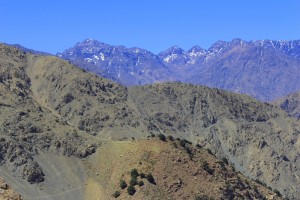My PhD investigates the floristic diversity and conservation biodiversity of Morocco using inventory, computer modelling and informatics approaches.
My PhD project focus on updating the endemic flora according to the new classification APG III, conservation assessments and Red listing of endemics in the important plant areas of Morocco and hotspots especially the Atlas mountains. In addition, the research explores the effect of climate change in the endemic flora and ecosystems and the changes in IUCN categories and criteria by time.
The flora of Morocco is one of the most diverse in the Mediterranean region and the richest in North Africa with about 4200 taxa including 1282 subspecies, contained in 920 genera and 130 families (Rankou et al., 2013).
This high plant diversity is explained by the geographical position of Morocco, its varied topography, geology, ecoregions and climate. In prehistory Morocco was a pathway for flora and fauna spreading to and from the Macaronesian Islands especially the Canary Islands, and, more importantly, Morocco formed a land bridge between Europe and Africa. Morocco is situated at a floristic crossroads due to two lengthy (c. 2800 km) sea coasts along the Atlantic Ocean and the Mediterranean Sea. This has resulted in a high habitat diversity and diverse ecoregions caused by a variety of Mediterranean-type climates along the coast, and from the Sahara in the south to the moist oceanic climate of the north.
As a result, Morocco contain one of the largest hotspot regions in the Mediterranean basin which covers four areas importantly the High Atlas (HA), Middle Atlas (MA), Anti Atlas (AA) and Rif (R) mountains and a high percentage of endemic species, 22%, which places Morocco in an important position among other Mediterranean countries.
The main threats to the Moroccan hotspots and their endemic plants are water stress (exacerbated by drought), overgrazing, climate change, deforestation, habitat fragmentation and isolation. In addition to the agriculture uses of the habitats, human interferences, tourism and urbanization are also major threats. However, not much is done in terms of plants conservation in the Moroccan hotspots and not much is done in term of habitat protection and the raising of public awareness about the importance of the areas significant biodiversity.
Therefore, conservation efforts are necessary in both the Mediteranean and Saharan ecoregions to preserve the biodiversity and botanical richness of Morocco.
The first chapter of my thesis; floristic studies of the Moroccan flora is now published as the February 2013 issue of Phytotaxa Journal.
Publications
Rankou, H. , Culham, A. , Jury, S. L. & Christenhusz, M. (2013) The Endemic Flora of Morocco. Phytotaxa. 78 (1): 1–69 http://www.mapress.com/phytotaxa/content/2013/pt00078.htm




is that daghmous?